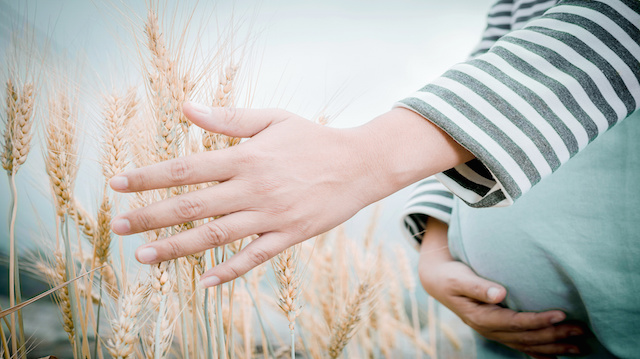
Remember sex ed class back in middle school? Depending on what school you attended, you may have been taught total abstinence, or scared off by horrific descriptions of sexually transmitted diseases, or maybe you were handed free condoms.
Unfortunately, what you probably didn’t learn is how to read and manage fertility naturally. That’s why so many women end up mindlessly using hormonal contraceptives, despite the risks of cancer, blood clots, and depression, to name just a few.
That’s what I did — for about ten years in fact. As I began researching more about nutrition and holistic health, I realized that I was potentially doing long-term damage to my body. In my case, it was the gut biome effects (predisposing me to Candida yeast overgrowth) and the nutrient deficiencies that I found the most concerning. I’ll never get those years back, but I sure am happy to have discovered a natural alternative.
I want to introduce you to a new approach to fertility. Let’s call it sex ed class, round two. This time it’s going to be a lot more personal, and maybe even a little bit spiritual, since we will be getting to know our own body’s beautiful fertility rhythms and signs so that we may recognize and respect them.
The fertility awareness method (FAM) can equally be used to get pregnant or to avoid pregnancy, because it’s all about knowing when you’re fertile and when you’re not. The majority of this article will be written with the assumption that you want to avoid pregnancy, but I will also address techniques to improve the chances of getting pregnant, if that’s your intention.
Note that for the first few months, it’s important to use a backup method of contraception (i.e., condoms) religiously while you observe the signs that your body gives you, and get to know your own rhythm.
Also note that if you are just coming off the pill, it may take a few months for your cycle to normalize. Until you’ve tracked a few cycles that are stable and predictable, continue to use backup contraception.
Finally, keep in mind that everyone’s body is different, and you must get to know your own. Be patient and observant. Don’t hesitate to consult with your trusted healthcare professional because this article provides an educational guideline only.
How to get started with the fertility awareness method
There are a couple of things you’ll need to get in order to prepare for using the fertility awareness method. The first is a basal body temperature thermometer. A regular thermometer won’t do — you need one that is accurate to two decimal places of a degree, i.e., 98.55. You can get a basal thermometer at the pharmacy or order one online — it shouldn’t cost more than 20 dollars.
Next you need an app to help track your fertility. I use and recommend Kindara. This app is purpose built for the fertility awareness method so there are ways to enter all of the necessary details and follow along on a visually appealing graph or calendar. If you don’t have a smartphone, don’t worry, some paper and a pen works just fine, too. I suggest buying a small notebook which you can dub your “fertility journal” to keep all the information in one place.
There are three things you will be tracking as part of the fertility awareness method.
The first is your basal body temperature. As mentioned above, you need a special thermometer to do this accurately. Your basal body temperature is measured right after you wake up, before you have risen from bed. This will become your new routine — roll over, turn off the alarm (if you use one) and reach for your basal thermometer. Stick it in your mouth and meditate on your morning for a moment until it beeps. Then record the temperature in your fertility journal or smartphone app.
Remember you must include the two decimal places. Why? It turns out, your temperature changes throughout your menstrual cycle. It starts out low, then goes up by a few fractions of a degree after you’ve ovulated. This is one of the simplest ways that we can tell which days of the month are fertile days.
The second thing you’ll be tracking is your cervical fluid. Yup, that’s the goopy stuff you might have noticed on your undies. Gross, right? Not really, it’s actually a totally awesome fertility mechanism that your body creates! All of us ladies make this stuff, so let’s get past the ick factor and learn more about it.
Your cervical fluid changes consistency throughout your cycle. There are four categories which you will need to learn to recognize. The first day of your cycle is when you begin to menstruate. This is day 1. After this finishes on day 5 or 6, there will typically be a few days of no cervical discharge. Then you will begin to notice a little bit of fluid. Let’s go through the four types, from the beginning of your cycle to the end.
Type 1: Sticky
This type of cervical fluid is whitish and a little bit tacky between your fingers. You will probably see this from about day 8 to day 11.
Type 2: Creamy
A little more liquid comes into the fluid at this stage and it becomes creamy like hand lotion. This type is observed around day 11–13.
Type 3: Egg white
This stage is entirely different — the fluid becomes clear and stretchy, like egg whites. The purpose of this fluid is to trap sperm and keep it inside the vagina, helping it survive and get to the egg. This is your most fertile stage. Between day 13 and day 18 is probably when you will see egg-white fluid.
Type 4: Watery
After you have ovulated, your cervical fluid becomes wet and either clear or slightly cloudy, and there might not be much of it. This type of fluid (or lack of fluid) occurs between day 18 and 28. After this, you will menstruate again (provided you are not pregnant).
So how do you check your cervical fluid? It might be visible on the toilet paper you use when you go to the bathroom. Otherwise, wash your hands thoroughly and go ahead and reach for your cervix. If yours doesn’t produce great amounts of fluid, you might actually have to touch it in order to get some on your fingers. Most people say your cervix feels a bit like the tip of your nose. If you find you need to touch it in order to check your fluid, keeping your nails short is a good idea so that you don’t damage the delicate tissue.
The following are the most important times to observe your fluid:
- The first time you see fluid in a new cycle. As I mentioned, after menstruation stops you will probably have a few days of nothing. Keep an eye on things — the first day you notice some sticky fluid, that means your fertile period is starting and it’s best to avoid unprotected sex.
- When you see egg-white fluid. This means you are ultrafertile! Definitely no unprotected sex during the egg-white phase, if you wish to avoid pregnancy.
 Each day, along with your temperature reading, note down the type of cervical fluid and the amount (a little, medium, or a lot) in your app or journal.
Each day, along with your temperature reading, note down the type of cervical fluid and the amount (a little, medium, or a lot) in your app or journal.
The third fertility sign you can track is your cervical position. I consider this to be optional, but it might be smart to track it for the first few months while you are getting used to observing your rhythm.
Your cervix is the opening to your uterus, and, as such, it actually softens, descends and opens up to receive sperm when you are fertile! How cool is that! At the beginning of your cycle you will be able to feel that your cervix is sitting up higher and is more firm, with a texture like the end of your nose. As things move on toward your fertile phase, the cervix comes downward and opens up, becoming softer and spongier. After ovulation, it closes, moves up and becomes firm again.
Keep track of these cervical characteristics in your app or journal, along with your morning temperature and cervical fluid observations. Also keep track of when you menstruate, as this constitutes day 1 of the cycle when everything begins again.
Recognizing peak fertility
Once you know how to read your body’s fertility signs, you’ll be able to pinpoint the few days of each month that you are actually able to conceive. Needless to say these are the days that you should use protection if you are hoping to avoid pregnancy.
Your most fertile day is also referred to as your “peak day.” Peak day can only be identified retrospectively, based on the fact that your basal body temperature will jump by about three-tenths of a degree and stay higher for three consecutive days. After your temperature has been higher for three days in a row, you will know that you ovulated around the first day of that three-day period.
However, once you’ve tracked a few cycles and have observed that your pattern is predictable, you’ll be able to anticipate peak day. Generally it occurs sometime between day 14 and day 18 of your cycle. This will coincide with the egg-white consistency of cervical fluid and the low, open, soft cervical position.
How to avoid pregnancy
The period when you should avoid unprotected sex is from 7 days prior to peak day until 3 days afterward (or if you are trying to conceive, this is when you should be going at it like rabbits!). The seven days prior is because sperm can survive in the vagina for a maximum of seven days following unprotected intercourse. The 3 days following is because your egg only stays viable for about 48 hours after exiting the ovary.
Outside of this time it is generally not possible to conceive. However, it’s important to note that things may be unpredictable if you have hormonal imbalances due to an illness or unhealthy habits. I recommend devoting yourself to fastidiously tracking a few cycles while also improving your diet, sleep, exercise, detoxification and stress-relief practices. This will help normalize and regulate your cycles as much as possible.
I hope that you’ve enjoyed this return to sex ed class, and found it entirely more enlightening and applicable! Now that you’re intimate with your own body’s subtle fertility messages, it’s like speaking a new language that was previously incomprehensible. You’re sure to be excited the first time you see that egg-white cervical fluid and actually know what it means (not just “gross”!).
If you’re wondering how to encourage your cycle to be more predictable so that you can have an easier time with the fertility awareness method, check out these hormone-stabilizing tips.
—Liivi Hess
Liivi is an Integrative Nutrition Health Coach and is training to become a doula. She inspires women to find peace and personal power by taking control of health and fertility naturally. Liivi‘s passion is ancestral nutrition and primal lifestyle design. She and her partner Will live between Toronto, Canada and Queenstown, New Zealand.
Sources:
http://www.webmd.com/infertility-and-reproduction/fertility-awareness
http://brown.edu/Student_Services/Health_Services/Health_Education/sexual_health/safer_sex_and_contraceptives/fertility_awareness_method.php
http://americanpregnancy.org/preventing-pregnancy/natural-family-planning
https://www.arhp.org/Publications-and-Resources/Quick-Reference-Guide-for-Clinicians/choosing/Fertility-awareness
https://www.kindara.com/avoid-pregnancy
http://humrep.oxfordjournals.org/content/22/5/1310.long
http://www.webmd.com/infertility-and-reproduction/fertility-tests-for-women?page=2
http://www.mayoclinic.org/tests-procedures/cervical-mucus-method/basics/definition/prc-20013005

